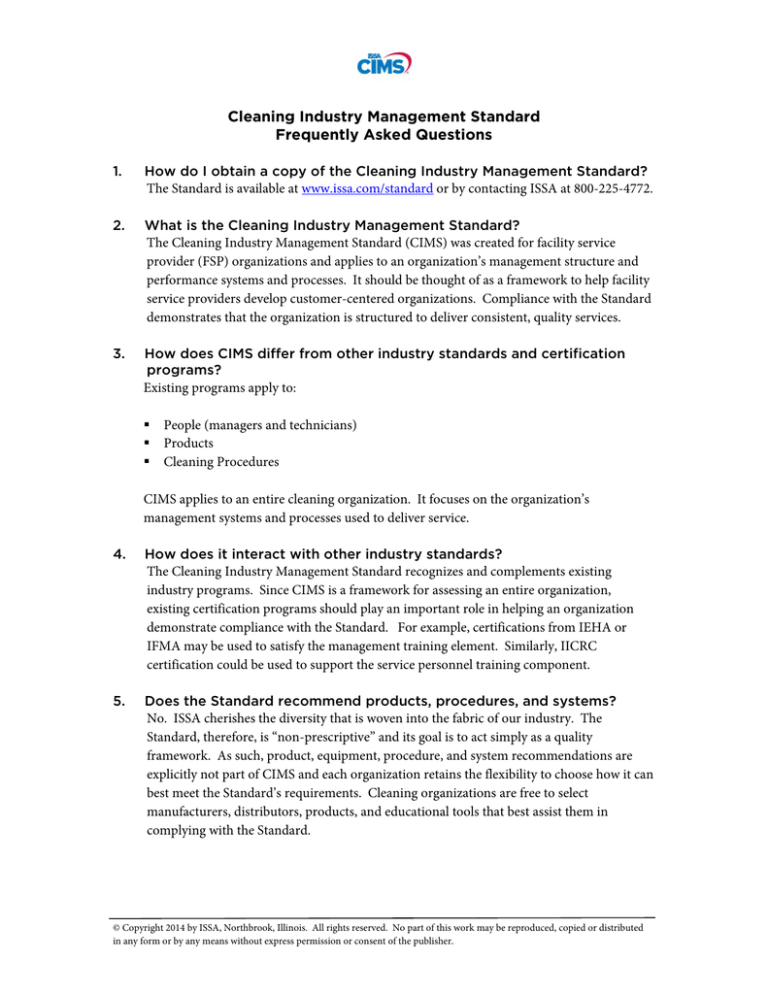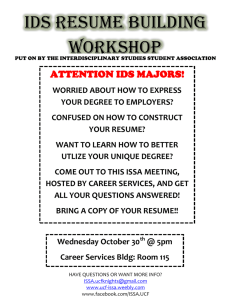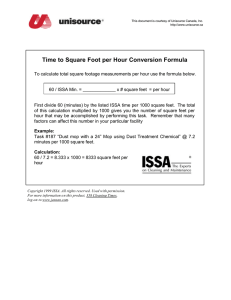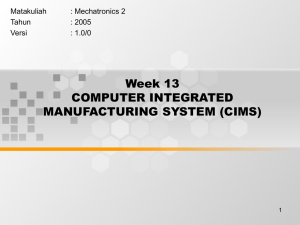
Cleaning Industry Management Standard
Frequently Asked Questions
1.
How do I obtain a copy of the Cleaning Industry Management Standard?
The Standard is available at www.issa.com/standard or by contacting ISSA at 800-225-4772.
2.
What is the Cleaning Industry Management Standard?
The Cleaning Industry Management Standard (CIMS) was created for facility service
provider (FSP) organizations and applies to an organization’s management structure and
performance systems and processes. It should be thought of as a framework to help facility
service providers develop customer-centered organizations. Compliance with the Standard
demonstrates that the organization is structured to deliver consistent, quality services.
3.
How does CIMS differ from other industry standards and certification
programs?
Existing programs apply to:
People (managers and technicians)
Products
Cleaning Procedures
CIMS applies to an entire cleaning organization. It focuses on the organization’s
management systems and processes used to deliver service.
4.
How does it interact with other industry standards?
The Cleaning Industry Management Standard recognizes and complements existing
industry programs. Since CIMS is a framework for assessing an entire organization,
existing certification programs should play an important role in helping an organization
demonstrate compliance with the Standard. For example, certifications from IEHA or
IFMA may be used to satisfy the management training element. Similarly, IICRC
certification could be used to support the service personnel training component.
5.
Does the Standard recommend products, procedures, and systems?
No. ISSA cherishes the diversity that is woven into the fabric of our industry. The
Standard, therefore, is “non-prescriptive” and its goal is to act simply as a quality
framework. As such, product, equipment, procedure, and system recommendations are
explicitly not part of CIMS and each organization retains the flexibility to choose how it can
best meet the Standard’s requirements. Cleaning organizations are free to select
manufacturers, distributors, products, and educational tools that best assist them in
complying with the Standard.
© Copyright 2014 by ISSA, Northbrook, Illinois. All rights reserved. No part of this work may be reproduced, copied or distributed
in any form or by any means without express permission or consent of the publisher.
6.
How is the Standard administered?
The Standard is administered by ISSA. ISSA, a not-for-profit association founded in 1923,
prides itself on being the leading association for the cleaning industry worldwide. ISSA
administration ensures that there is no commercial bias to any group.
7.
Who developed the Standard?
The Standard was developed through a true consensus-based process. Experts,
representing all sectors of the industry, including the facility management and purchasing
communities, were selected by the ISSA Board, staff, and alliance partners to participate on
standard-development Technical Committees. The committees worked directly with ISSA
and its partner, the American Institute for Cleaning Sciences (AICS) to draft the Standard,
which was subject to full peer review prior to official publication.
8.
What was ISSA’s role in developing the Standard?
ISSA provided organizational oversight by leveraging its unique role in the industry. ISSA’s
diverse membership is comprised of:
Manufacturers
Distributors
Manufacturer Representatives
Facility Service Providers
Industry Consultants
The shared interests of its membership base enabled ISSA to provide the necessary
oversight. In addition, the many alliances that ISSA has developed with leading
organizations in the cleaning and facilities management industries lent valuable insight to
ensure a balanced and comprehensive approach.
9.
What does the Standard consist of?
The Standard is based on universally accepted management principles and consists of five
sections of management best practices:
1.
2.
3.
4.
5.
Quality Systems
Service Delivery
Human Resources
Health, Safety, and Environmental Stewardship
Management Commitment
10. What does it mean to become certified to the Standard?
Certification indicates that an organization conforms to the requirements set forth in the
Standard and has successfully demonstrated compliance to an independent, accredited
assessor.
© Copyright 2014 by ISSA, Northbrook, Illinois. All rights reserved. No part of this work may be reproduced, copied or distributed
in any form or by any means without express permission or consent of the publisher.
11.
Does an organization need to meet every element in order to earn
certification?
No. The Standard was designed to focus on performance and recognizes the need for
flexibility and practical application.
Organizations seeking certification must demonstrate compliance with all mandatory
provisions and at least 60%, per section, of those provisions that are included as
recommended elements of the Standard.
12. What is the process for an organization to become certified?
An organization achieves certification by demonstrating that its management structure and
processes conform to the Standard. The certification process is simple.
1. The organization decides that it wants to develop a quality management system that
complies with CIMS, and requests an application.
2. The organization conducts an internal review to be sure that it meets CIMS
certification requirements.
3. The organization undergoes a comprehensive assessment by an independent thirdparty and demonstrates compliance with CIMS. The independent third party that
assesses compliance is known as an assessor.
4. An organization applies for re-certification every two years.
13.
Who will determine whether a cleaning organization is in compliance
with the Standard and eligible for CIMS certification?
Cleaning organizations are encouraged to have their systems and processes reviewed by an
“assessor.” An assessor is an independent third-party that has earned accreditation by
demonstrating that he/she can competently and independently verify that an organization
meets the Standard’s requirements.
14. Does the Standard apply to all FSP market segments?
Yes. The Standard applies to all FSP organizations – building service contractors (BSCs)
and in-house organizations – regardless of organization size.
15.
How will the ISSA Cleaning Industry Management Standard benefit FSPs?
The process of complying with the Standard provides the greatest benefit. While
certification to the Standard will likely be the end goal, the process itself challenges and
improves an FSP’s operation.
In-house organizations will use the Standard to:
Develop an organization master plan
Operate more efficiently
Develop best practices
Validate performance and quality
© Copyright 2014 by ISSA, Northbrook, Illinois. All rights reserved. No part of this work may be reproduced, copied or distributed
in any form or by any means without express permission or consent of the publisher.
Building service contractors will find that the Standard will help them:
Distinguish themselves from their competitors
Improve their bottom line
Better meet the demands of their customers
Improve the overall quality of their services
16. What role will distributors and manufacturers play?
Distributors, manufacturers and manufacturer representatives will play an essential role.
Since the Standard rewards systemic approaches to product selection, training, and
management it will be a catalyst for sales. Other benefits include:
Closer ties to customers
Enhanced professional image for the industry
Growth opportunities
Distinctive marketing position
Business resource to customers
Distributors, manufacturers, and others are encouraged to become “ISSA Certification
Experts” (I.C.E.) to uniquely position themselves to assist their facility service provider
customers in preparing for CIMS certification
17.
What is the role for industry consultants?
The Standard creates numerous opportunities for industry consultants. Consultants benefit
as FSP organizations seek expertise to assist them in developing programs to meet the
Standard, thereby creating a vast array of service opportunities. Training, documentation,
and quality assurance are just a few of the services that will be needed.
18.
How is CIMS different from ISO?
CIMS and ISO are similar in many respects, but CIMS has the advantage of having been
developed specifically "by the cleaning industry and for the cleaning industry" (with a large
dose of assistance from the facility management and purchasing communities).
The fact that the program was developed specifically for the cleaning industry offers
tangible benefits. First of all, CIMS deals with the unique issues faced by cleaning
organizations on a daily basis (ISO was originally developed for manufacturing and was
drafted to speak to that industry). Second, compliance with the Standard is determined by
an individual who is an expert in the cleaning industry. One of the primary concerns with
ISO, as it applies to the cleaning industry, centers on the fact that the auditors generally do
not know anything about the particulars of our industry. The CIMS assessors, on the other
hand, are required to have practical industry experience and, therefore, truly understand its
unique nature.
© Copyright 2014 by ISSA, Northbrook, Illinois. All rights reserved. No part of this work may be reproduced, copied or distributed
in any form or by any means without express permission or consent of the publisher.







